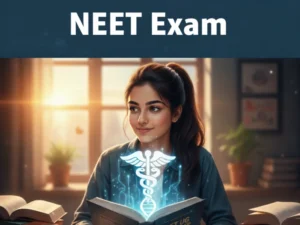If you want to pursue a career in the medical field, then you must know about the NEET exam. NEET is India’s largest entrance examination for undergraduate medical courses. NEET stands for National Eligibility cum Entrance Test. This exam is conducted by NTA once annually, generally in May. In this article, you get all the required information about this exam.

What is NEET Exam?
Before 2013, students had to apply and appear in different exams for different universities. To solve this problem, the government introduced the one Nation one example policy. As a result, the NEET exam was introduced as a nationwide medical entrance test for government and private colleges.
This exam is conducted by the National Testing Agency (NTA). This agency is responsible for the entire examination process, from releasing the application form to conducting the exam to announcing the results and final ranks.
Eligibility for the NEET Exam
Before you start preparation for the exam, you must know the eligibility requirements for this exam. Here are some points to be noted.
Nationality:
The exam is open to Indian Citizens, Non-Resident Indians (NRIs), Overseas Citizens of India (OCI), Persons of Indian Origin (PIO), and Foreign Nationals.
Age Limit:
You must be at least 17 years old by December 31 of the admission year. There is no upper age limit to appear for NEET.
Academic Qualification:
You must have passed or be appearing for your Class 12 (or equivalent) examination with Physics, Chemistry, and Biology/Biotechnology as core subjects, along with English.
Minimum Marks in Class 12:
A minimum aggregate score is required in PCB (Physics, Chemistry, Biology/Biotechnology)
- General category: At least 50%
- OBC/SC/ST categories: At least 40%
- Persons with Benchmark Disability (PwBD): 45% (for General-PwBD)
Application Process for NEET Exam
Usually, between December and March, on the official website of NTA, https://neet.nta.nic.in, registration forms are open every year. You have to keep an eye on the NTA official notification for exact registration window dates. The registration typically lasts 4-5 weeks.
Step-by-Step Guide to Filling out the Application Form
Registration:
You have to create an account using your basic details, mobile number, and email. After that, an application number will be generated.
Fill the Application Form:
In this step, log in and provide detailed personal, academic, and contact information. You have to select the preferred exam cities.
Upload Documents:
In this section, you have to upload scanned copies of your photograph, signature, and other required certificates( for example, OBC, ST/SC, EWS, or PWD) in the specified format and size.
Pay the Fee:
Before this step, kindly check your application to make sure you fill in all the right information. Pay the application fee online via debit/credit card, net banking, or UPI to complete the process.
Print Confirmation Page:
After successful payment, download and print the confirmation page for future reference.
The NTA will provide a correction window for the candidates to correct mistakes in personal or academic information, except for certain fields that cannot be changed (e.g., mobile number, email).
Application Fees (2025)
For different categories, the application fee is mentioned in the table.
| Category | Fee |
| General / NRI | ₹1,700 |
| General-EWS / OBC-NCL | ₹1,600 |
| SC / ST / PwD / Third Gender | ₹1,000 |
| Outside India | ₹9,500 |
Exam Pattern and Structure
This exam is an Offline Pen-and-Paper and OMR sheet. In NEET, the total number of questions is 180 from Physics, Chemistry, Biology (Botany & Zoology).
- Physics: 45 questions
- Chemistry: 45 questions
- Biology: 90 questions (Botany: 45, Zoology: 45)
All questions are compulsory, multiple-choice (MCQs) with four options. There are no optional questions; every question must be answered within a time duration of 3 hours (180 minutes).
Marking Scheme
Positive/Negative Marks, Unanswered Questions
- Correct Answer: +4 marks
- Incorrect Answer: -1 mark
- Unanswered Question: 0 marks (no penalty)
- Multiple answers marked for a question: -1 mark
- Maximum Total Marks: 720
NEET Syllabus Overview
The NEET syllabus is extensive and covers the core concepts from Class 11 and 12 NCERT textbooks.
Physics Key Topics
Class 11: Physical World & Measurement, Kinematics, Laws of Motion, Work/Energy/Power, Rotational Motion, Gravitation, Properties of Solids & Liquids, Thermodynamics, Kinetic Theory, Oscillations & Waves
Class 12: Electrostatics, Current Electricity, Magnetic Effects, Electromagnetic Induction, Alternating Currents, Electromagnetic Waves, Optics, Dual Nature of Matter, Atoms & Nuclei, Electronic Devices
Chemistry Key Topics
Class 11: Basic Concepts, Atomic Structure, Periodic Table, Chemical Bonding, States of Matter, Thermodynamics, Equilibrium, Hydrogen, s- and p-block Elements, Environmental Chemistry
Class 12: Solid State, Solutions, Electrochemistry, Chemical Kinetics, Surface Chemistry, d- & f-block Elements, Coordination Compounds, Organic Chemistry (Aldehydes, Ketones, Amines, Biomolecules, Polymers)
Biology Key Topics
Class 11: Diversity in Living Organisms, Structural Organization in Plants & Animals, Cell Structure, Plant Physiology, Human Physiology
Class 12: Reproduction, Genetics & Evolution, Biology & Human Welfare, Biotechnology, Ecology & Environment
For the full, updated syllabus, always refer to the official NTA NEET syllabus page.
Qualifying cut-off by Category:
Qualifying score is the minimum marks to be eligible for counseling. Competitive score is typically 580+ for MBBS in top government colleges, varies by reservation category and state quota.
Qualifying score (out of 720 total):
- General/EWS: 137–147
- OBC/SC/ST: 107–115
- PwD: 116–129 (general), 104–120 (reserved)
The NEET exam remains the most crucial gateway to medical education in India, setting the benchmark for aspiring doctors, dentists, and health professionals every year. Staying updated with official notifications, practicing with mock tests, and learning from NEET toppers’ strategies are vital steps for maximizing scores.
Form more exams visit our website studyop.in